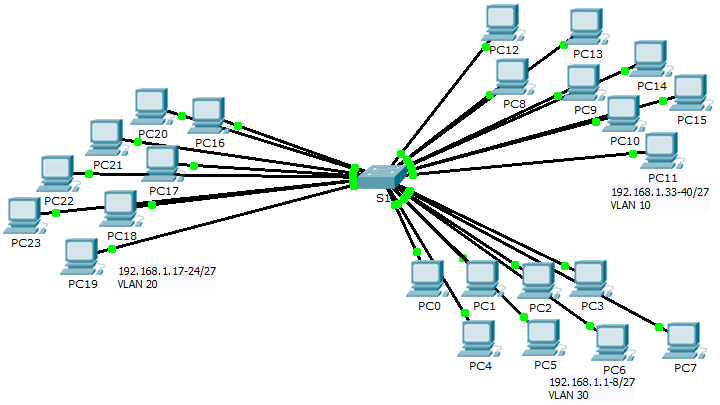Last Updated on March 23, 2018 by Admin
6.1.1.5 Packet Tracer – Who Hears the Broadcast
From year to year, Cisco has updated many versions with difference questions. The latest version is version 6.0 in 2018. What is your version? It depends on your instructor creating your class. We recommend you to go thought all version if you are not clear. While you take online test with netacad.com, You may get random questions from all version. Each version have 1 to 10 different questions or more. After you review all questions, You should practice with our online test system by go to "Online Test" link below.
Packet Tracer – Who Hears the Broadcast? (Answer Version)
Answer Note: Red font color or Gray highlights indicate text that appears in the Answer copy only.
Topology

6.1.1.5 Packet Tracer – Who Hears the Broadcast
Objectives
Part 1: Observe Broadcast Traffic in a VLAN Implementation
Part 2: Complete Review Questions
Scenario
In this activity, a 24-port Catalyst 2960 switch is fully populated. All ports are in use. You will observe broadcast traffic in a VLAN implementation and answer some reflection questions.
Part 1: Observe Broadcast Traffic in a VLAN Implementation
Step 1: Use ping to generate traffic.
- Click PC0 and click the Desktop tab> Command Prompt.
- Enter the ping 192.168.1.8 command. The ping should succeed.
Unlike a LAN, a VLAN is a broadcast domain created by switches. Using Packet Tracer Simulation mode, ping the end devices within their own VLAN. Based on your observation, answer the questions in Step 2.
Step 2: Generate and examine broadcast traffic.
- Switch to Simulation mode.
- Click Edit Filters in the Simulation Panel. Uncheck the Show All/None checkbox. Check the ICMP checkbox.
- Click the Add Complex PDU tool, this is the open envelope icon on the right toolbar.
- Float the mouse cursor over the topology and the pointer changes to an envelope with a plus (+) sign.
- Click PC0 to serve as the source for this test message and the Create Complex PDU dialog window opens. Enter the following values:
- Destination IP Address: 255.255.255.255 (broadcast address)
- Sequence Number: 1
- One Shot Time: 0
- Within the PDU settings, the default for Select Application: is PING. What are at least 3 other applications available for use?
- DNS, FINGER, FTP, HTTP, HTTPS, IMAP, NETBIOS, PING, POP3, SFTP, SMTP, SNMP, SSH, TELNET, TFTP and OTHER
- Click Create PDU. This test broadcast packet now appears in the Simulation Panel Event List. It also appears in the PDU List window. It is the first PDU for Scenario 0.
- Click Capture/Forward twice. What happened to the packet? The packet is sent to the switch and then broadcast to all of the PCs that belong to the same VLAN and in this case, VLAN 10.
- Repeat this process for PC8 and PC16.
Part 2: Complete Review Questions
- If a PC inVLAN 10 sends a broadcast message, which devices receive it? All end devices on VLAN 10
- If a PC in VLAN 20 sends a broadcast message devices receive it? All end devices on VLAN 20
- If a PC in VLAN 30 sends a broadcast message devices receive it? All end devices on VLAN 30
- What happens to a frame sent from a PC in VLAN 10 to a PC in VLAN 30? It will be dropped because they are not on the same VLAN.
- Which ports on the switch light up if a PC connected to port 11 sends a unicast message to a PC connected to port 13? Ports 11 and 13 will light up.
- Which ports on the switch light if a PC connected to port 2 sends a unicast message to a PC connected to port 23? The packet will be dropped.
- In terms of ports, what are the collision domains on the switch? Each port is its own collision domain.
- In terms of ports, what are the broadcast domains on the switch? Each VLAN is its own broadcast domain.
From year to year, Cisco has updated many versions with difference questions. The latest version is version 6.0 in 2018. What is your version? It depends on your instructor creating your class. We recommend you to go thought all version if you are not clear. While you take online test with netacad.com, You may get random questions from all version. Each version have 1 to 10 different questions or more. After you review all questions, You should practice with our online test system by go to "Online Test" link below.
Suggested Scoring Rubric
There are 10 questions worth 10 points each.